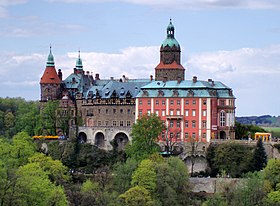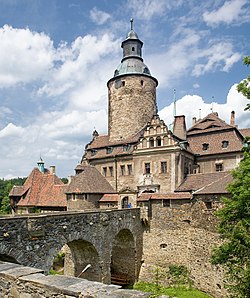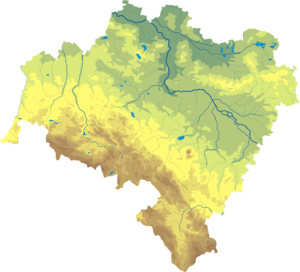Lower Silesian Voivodeship
Lower Silesia[1] (Polish: Dolnośląskie) is a voivodeship (province) of Poland, located in the southwest of the republic in the historic Silesia region. A tumultuous battleground between Europe's dynastic and imperial powers for over a thousand years, Lower Silesia's cultural and political borders have shifted considerably in the last millennium. Previously a constituent part of Germany, the region was annexed by Poland in 1945 following the aftermath of the Second World War. Historically, the province has strong connections to German and Polish culture, with additional Czech influence felt in its southern regions. Today, the province is well-known as a popular destination for holidaymakers due to its high density of spa towns scattered across its mountainous south. Wrocław, the Lower Silesian capital, is one of Poland's largest and most dynamic cities with a growing international profile, and stands as one of the most important commercials, educational, and tourist centers in the country. Lower Silesia is also one of Poland's most economically wealthy and most visited voivodeships. Regions[edit]Cities[edit]As of 2013, the population of Lower Silesia numbered 2,914,362 inhabitants. Most of Lower Silesia's population is concentrated in the vicinity of Wrocław, around the province's northern agricultural plains, and along the A4 motorway. The province's mountainous south is less densely populated, though several larger cities and towns, including Wałbrzych and Kłodzko, are located within this region. Cities and towns with the word Zdròj (Polish for bath and spa) in their name denote a location with a historical spa legacy.
Other destinations[edit]
Understand[edit]History[edit]Lower Silesia is thought to have been inhabited by humans for nearly 230,000 to 100,000 years. Anatomically modern humans, believed to be hunters and gatherers, arrived in the last Ice Age. Between 4000 to 1700 BCE, the first rural communities began to be constructed by people possessing skills in pottery, animal husbandry, agriculture, and primitive forms of mining.  A view above Wrocław. In the La Tène cultural period (450 BCE-100 AD), Lower Silesia was inhabited by Celtic tribes, who had their main place of a cult on the Mount Ślęża. Their stony statues situated on and around this hill were later worshiped by Slavic tribes who arrived later. Magna Germania (second century AD) records that between the Celtic and Slavic periods, Lower Silesia was also inhabited by a number of Germanic tribes. Among them were the Vandals, the Lugii, and the Silingi, who might have given the Silesia region its name, though it is unclear and thus disputed. With the Germanic tribes leaving westward during the Migration Period, a number of new peoples arrived in Silesia from Sarmatia, Asia Minor, and the Asian steppes from the beginning of the sixth century. The Bavarian Geographer (c. 845) referred to the West Slavic Ślężanie (the other possible source of the region;s Polish name Śląsk), centered around Niemcza, and Dziadoszanie tribes, while a 1086 document issued by Bishop Jaromir of Prague listed the Zlasane, Trebovane, Poborane, and Dedositze. In the late 9th century, the region was a subject to the Great Moravian realm of Prince Svatopluk I. In 906, the region came under the rule of Přemyslid duke Spytihnev I of Bohemia and his successors Vratislaus I, the alleged founder of Wrocław (Czech: Vratislav), and Boleslaus the Cruel. Meanwhile, the West Slavic Poles established the first duchy under the Piast dynasty in the adjacent Greater Poland region to the north. About 990, Silesia was conquered and incorporated into the first Polish kingdom by the Piast duke Mieszko I, who gained support from Emperor Otto II against Bohemian duke Boleslaus II. In 1000 his son and successor, Bolesław I Chrobry, founded the Diocese of Wrocław, which, together with the Bishoprics of Kraków and Kołobrzeg, was placed under the Archbishopric of Gniezno in Greater Poland, founded by Emperor Otto III at the Congress of Gniezno that same year. The ecclesiastical suzerainty of Gniezno over Wrocław lasted until 1821. After a temporary shift to Bohemia in the first half of the 11th century, Lower Silesia continued to be an integral part of the Polish kingdom until the end of its fragmentation period, when all Polish claims were renounced in favor of the Bohemian kingdom in 1348. The Duchy of Silesia was first split into lower and upper parts in 1172 during the period of Poland's feudal fragmentation when the land was divided between two sons of former High Duke Władysław II. The elder Bolesław the Tall ruled over Lower Silesia with his capital in Wrocław (then known as Vratislav, Wrotizla, or Prezla), and younger Mieszko Tanglefoot ruled over Upper Silesia with his capital first in Racibórz, then later in Opole after 1202. Silesia was later divided into as many as 17 duchies. With the 1335 Treaty of Trentschin and the 1348 Treaty of Namslau, most of the Silesian duchies were ruled by the Silesian Piast dukes under the feudal overlordship of the Bohemian kings, thus becoming part of the Crown of Bohemia. In 1476, the Crossen district became part of the Margraviate of Brandenburg, when the widow of the Piast ruler, Barbara von Brandenburg, daughter of Elector Albert Achilles, inherited Crossen. In 1526 Silesia was acquired by the Austrian Habsburg monarchy after the death of King Louis II of Bohemia. Brandenburg contested the inheritance, citing a treaty made with Frederick II of Legnica, yet Silesia largely remained under Austrian control until 1742. Most of Lower Silesia, except for a southern portion of the Duchy of Nysa, became part of the Kingdom of Prussia in 1742 after the First Silesian War under the Treaty of Breslau. In 1815, the region became part of the Prussian Silesia Province, which was then divided into two Lower Silesian administrative regions, the Regierungsbezirke of Legnica (German: Liegnitz) and Breslau (sometimes also referred to as Middle Silesia), and Upper Silesian Oppeln (including the Lower Silesian districts of Nysa and Grodków). The western Liegnitz region was enlarged by incorporating Upper Lusatian districts of Lauban, Görlitz, Rothenburg and Hoyerswerda, all seized from Saxony after the Napoleonic Wars. By the beginning of the 20th century, Lower Silesia was near exclusively ethnically and linguistically German, with the exception of a small Polish-speaking area in the northeastern part of the district of Namslau, Syców, and Milicz, and a small Czech minority in the rural areas around Strzelin. In the aftermath of World War I, Upper Silesia was divided between the Weimar Republic, the Second Polish Republic, and Czechoslovakia after a series of short border wars and popular armed insurgencies, while Prussian Lower Silesia remained within Weimar Germany, re-organized as the Lower Silesian Province of the Prussian Free State, consisting of the Breslau and Liegnitz regions.  A rock formation in Karkonoski National Park. Near the end of the Second World War in February 1945, the province was the scene of fierce fighting between Soviet and retreating German forces. In Breslau (modern-day Wrocław), the Russians entrapped the large Nazi garrison in the city, laying siege to the city until the end of the war. For nearly three months, intense street-by-street fighting, aerial and artillery bombardments obliterated nearly the entire city. Upon Germany's unconditional surrender in May, Breslau was one of the final cities in the Third Reich to lay down its arms. Following the end of the war, all territories east of the Oder-Neisse line were placed under Polish administration according to the Potsdam Agreement and were consequently annexed by Poland. During the incorporation, nearly all of historic Lower Silesia became part of Poland as part of the "recovered territories," while Germany retained a small portion of Lower Silesia to the west of the Oder-Neisse line in the current state of Saxony. The territory's German populations either fled or were forcefully expelled, replaced by Poles who themselves had previously been expelled from eastern areas annexed by the Soviet Union. Between 1945 to 1975, Lower Silesia was administered within Wrocław Voivodeship. As a result of the Local Government Reorganisation Act of 1975, Poland's regional administration was reorganized into 49 voivodeships, four of them in Lower Silesia: Jelenia Góra, Legnica, Wałbrzych, and Wrocław Voivodeships, a situation lasting until 1998. As a result of the 1998 Local Government Reorganisation Act, these four provinces were joined into the Lower Silesian Voivodeship, with Wrocław named as the capital. Today, Lower Silesia is nearly entirely ethnically Polish, yet traces of Austrian, Prussian, and German influences remain in architecture, infrastructure, and cuisine. Towards the south of the province, strong ties with the Czech Republic link many communities on both sides of the border together. In Wrocław, a small (yet steadily growing) Spanish, Portuguese and Italian population now calls the city home. Geography[edit]Lower Silesia is 19,946.74 km 2 (7,701.48 sq mi) large. The landscape of the province is varied, consisting of urban areas, villages, rolling farmlands, forests, and mountain ranges with jagged, unusual rock formations. Some of the geographic regions of Lower Silesia include:
Talk[edit]Like elsewhere in Poland, all native residents of Lower Silesia speak Polish, a Slavic language spoken by over 40 million. As Lower Silesia had a majority German population until 1945, visitors should not be surprised to see faded German language signs on older buildings, though today, German is spoken only infrequently and nearly exclusively for German-speaking tourists only. In the province's east, a small minority of people near the border with Opole Voivodeship can be overheard conversing in Silesian, a debated dialect strongly related to both Polish and Czech. Within the capital of Wrocław, tourists can frequently find information boards in English and German to assist their needs. There are also several basic information services available in the capital city for Italian, Spanish and Russian speakers. Most younger Poles of the post-1989 generation carry some working knowledge of English, as well as perhaps a limited knowledge of German. On the other hand, older individuals quite often understand basic German or Russian. Czech, a related Slavic language, can be partially understood by many Poles, albeit there are several significant (and sometimes humorous) word differences between both tongues. Basic knowledge of a few words or key Polish phrases will be generally warmly welcomed with smiles by the locals. Get in[edit]Several major airlines, including SAS Scandinavian Airlines, Lufthansa, Etihad Regional and Poland's national carrier LOT provide regular service to Wrocław–Copernicus Airport (WRO), Lower Silesia's major international gateway. Additional low-cost airlines flying to and from Wrocław include Germanwings, Ryanair and Wizz Air. Domestic flights operated by LOT's daughter company Eurolot connect Wrocław with Gdańsk. Get around[edit]By train[edit]Wrocław Główny station serves as the principal hub for all rail transport throughout Lower Silesia and marks an excellent starting point for tourists traveling the province by train. National rail operator PKP Intercity provides service from Wrocław to Poland's other major cities. Przewozy Regionalne, the national regional line, provides services between regions and smaller communities. The province's own rail operator, Koleje Dolnośląskie, provides service to a number of the province's cities, towns, and smaller municipalities, with Wrocław as its hub. By bus[edit]Like elsewhere in Poland, Lower Silesia is linked by a complex bus network, with a variety of companies offering transportation links to and from many of Lower Silesia's cities and smaller communities, as well as to other municipalities across the country. PolskiBus, one of Poland's more comfortable national bus carriers, offers connections from Wrocław to many other larger cities throughout the country and beyond. International bus carrier Eurolines also operates international coach service to and from Wrocław. Coach companies Link-Bus and Lajkonik offer bus links operating between Wrocław and Kraków. Latvian bus company Ecolines services Wrocław from locations around central and eastern Europe, though the service does not provide interprovincial travel. A slew of smaller companies offers routes to other communities and towns around Lower Silesia and beyond, which can be researched by e-podroznik.pl. By car[edit]Running west from the German border to southeast, the province is girdled by the A4 motorway, Poland's principal southern motorway. The additional A18 motorway provides a further connection to Germany. Stretching from Wrocław to the northeast, the S8 expressway links the capital to Greater Poland Voivodeship and to Łódź. The future S5 expressway (currently partially completed and under construction) will link Wrocław to Poznań in the coming years. The S3 expressway (currently being planned) will link the province to Lubusz Voivodeship to the northwest and travel through the province towards the Czech border. Elsewhere throughout Lower Silesia are smaller national roads (marked by red and white signs) and lower-level voivodeship roads (marked by yellow and black signs). See[edit]UNESCO World Heritage Sites[edit]
Do[edit] The grand spa buildings in Lądek-Zdrój.
Eat[edit] The quaint town center of Bolesławiec. Standard Polish staples, including pierogi, bigos, golonka, gołąbki, kiełbasa, gulasz, and fish plates, are readily found in many of Lower Silesia's restaurants. Silesian cuisine (kuchnia śląska) can also be found in some restaurants. A rich food profoundly influenced by Polish, German, Czech, and Hungarian culinary habits, is generally known for being heavy and rich. Silesian dumplings (kluski śląskie) can also be found in the region. Within Wroclaw, more international cuisines can be readily found, including Japanese, Indian, French, Korean, and Spanish. Drink[edit]Due to its history being strongly connected with Germanic and Slavic culture, Lower Silesia retains a strong beer-brewing tradition stretching back for centuries. Piast Wrocławski and Piast Mocne beer, regional favorites from the Piast brewery, are strongly connected to Wrocław's history and can be readily found in many bars, restaurants, and shops throughout the province. Wrocław is also the host of the annual Good Beer Festival (V Festiwal Dobrego Piwa), one of the largest beer festivals of its kind in the country, held normally at the beginning or the middle of May. The province is also home to one of the premier wine regions in the republic. Although the Polish wine industry is small and still developing compared to other more established Central European markets and traditions like those in the neighboring Czech Republic, Germany, or further south in Hungary, wine connoisseurs can appreciate Lower Silesia's small wineries. Most of them are concentrated in the province's center near Wrocław and Środa Śląska. Some wineries include Winnice Jaworek, Winnica Świdnicka, and Winnica Adoria. In Środa Śląska, an annual wine festival (Święto Wina w Mięście Skarbów) is held usually at the beginning of September. In the rural areas of Lower Silesia, many families continue to make śliwowica, a strong plum brandy. It is often drunk as an aperitif both before or after a meal and is also used often during family or community celebrations. Vodka, a standard Polish drinking staple, is also widely found and drunk throughout the province. Stay safe[edit] Książ Castle in Wałbrzych. Tourists in Wrocław should be aware of pickpockets, though this advice is standard in most large European cities. Violent crime is extremely rare in Lower Silesia and elsewhere throughout Poland, but individuals should nonetheless take precautions for their surroundings. Visitors hiking in the countryside and in the mountainous south should display caution when climbing on rock surfaces after recent rain or snow. In case of an emergency, people can dial the all-purpose emergency number 112 on their phone. For a better specification of the kind of emergency service you are requesting, people can dial 999 for an ambulance, 998 for a fire emergency, and 997 for the police. Get out[edit]Lower Silesia borders three other voivodeships: Lubuskie to the northwest, Greater Poland to the northeast, and Opole to the east. As an international border area, both the Czech Republic to the south and Germany in the west, are easily within reach by car, rail, and bus. Wrocław airport offers low-cost airlines with many destinations in Ukraine and Kutaisi, Georgia. They also have seasonal connections between Croatia and Podgorica, Montenegro.
Wikipedia:Lower Silesian Voivodeship WikiPedia:Lower Silesian Voivodeship |
|
|||||||||||||||||||||||||||||||||||||







